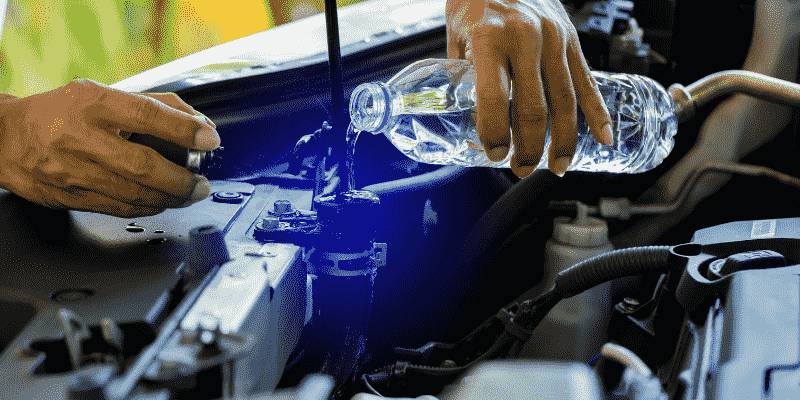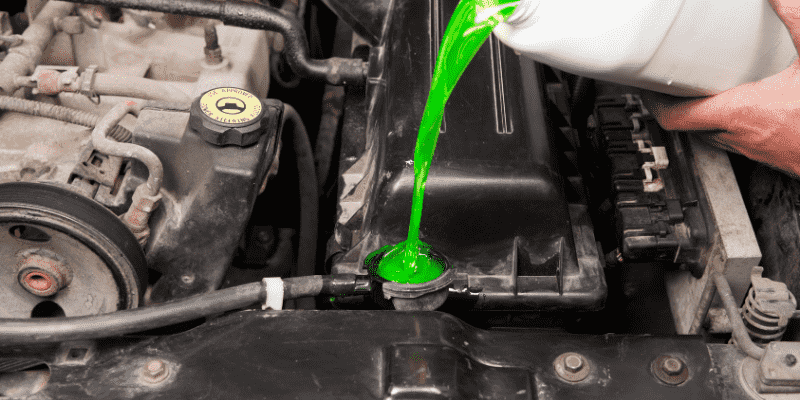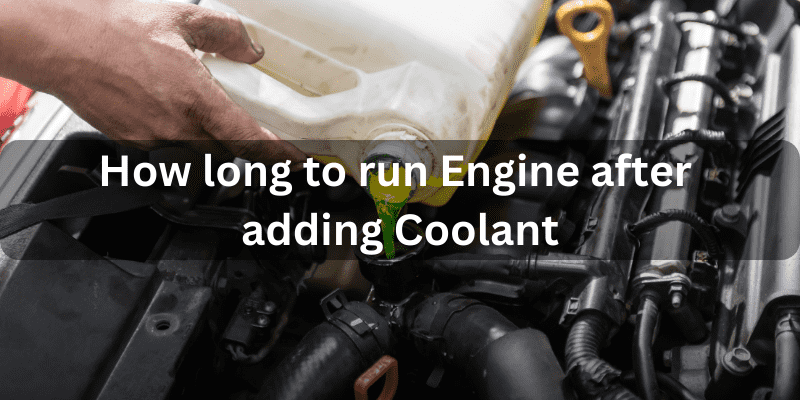Adding coolant to your car’s engine is crucial for keeping it running at the proper temperature. But how long should you run the engine after adding coolant? Running the engine immediately could lead to damage, so it’s important to wait before driving off.
In this article, we’ll discuss when and why you need to add coolant, the proper way to add it, how long you should wait before running the engine, and the precautions you need to take. We’ll also provide tips on keeping your engine cool and healthy in the long run. Read on to make sure you’re adding coolant the right way!
Understanding the Importance of Coolant
Coolant, also known as antifreeze, is a liquid that circulates through your engine to keep it from overheating. It absorbs excessive heat from the engine and radiates it through the radiator. The coolant also keeps the engine from freezing in cold temperatures.
Without enough coolant, your engine can easily overheat. An overheated engine can lead to blown head gaskets, cracked engine blocks, and damage to other components. That’s why it’s crucial to maintain the proper coolant level and add more when needed.
How long to wait before adding coolant?
There are a few signs that indicate you need to add more coolant:
- The coolant reservoir is low. There should be coolant up to the “Full” line.
- The engine is running hotter than normal or overheating.
- You frequently need to add coolant to maintain the level. This could indicate a leak.
- The coolant is old and needs to be flushed out. Coolant should be replaced every 3-5 years.
Check the coolant level regularly and add more if it’s low. Top it up to the proper level but don’t overfill.
When to Add Coolant to your car? 5 signs engine needs coolant
To determine when to add coolant, you can refer to the coolant level indicator on your car’s dashboard. Additionally, if you notice any signs of overheating, such as steam coming from the hood or the engine temperature gauge rising, it is advisable to add coolant immediately.
It is recommended to add the best engine coolant when the engine is cool to avoid burns or injuries. It is important to use the right type of coolant for your car and follow the manufacturer’s instructions for proper coolant maintenance. Regularly checking and adding coolant will help keep your car’s engine running smoothly and extend its lifespan.
Along with the coolant reservoir being low, watch for these signs that your engine may be low on coolant:
1. The temperature gauge reads higher than the normal
2. You get an engine temperature warning light
3. You hear bubbling noises from the engine
4. Steam is coming from the front of the car
5. The heater isn’t blowing hot air

If you notice any of these symptoms, safely pull over and check the coolant level under the hood. Top it up if needed and have the cooling system inspected for leaks.
How to Add Coolant if the engine is hot?
When adding coolant to the car, follow these steps:
- Make sure the engine is completely cool before removing the radiator cap.
- Check the coolant level in the reservoir. Top it up to the “Full” line if needed.
- Open the radiator cap slowly to relieve any pressure.
- Add the recommended coolant mixture directly to the radiator. Don’t overfill.
- Replace the radiator cap securely.
- Add more coolant to the reservoir up to the proper level.
- Check for leaks and have any found leaks repaired.
Only add coolant when the engine is cold. If it’s hot, wait until at least it cools down to avoid being burned by hot coolant and steam.
Waiting Time Before Running the Engine
Once you add coolant, don’t run the engine right away. Here are some guidelines on how long you should wait:
- If the engine is stone cold, wait about 5 minutes before starting it.
- If the engine is warm but not hot, wait about 10-20 minutes.
- If the engine was overheating or very hot when you added the coolant, wait 30 minutes or longer for it to completely cool.
Why You Should Wait Running When Adding Coolant?
Starting the engine too soon after adding coolant can cause problems:
- Coolant needs time to circulate and reach all parts of the engine. Running it immediately could lead to overheating in spots the new coolant hasn’t reached yet.
- Starting a hot or warm engine too soon puts extra stress on the engine components. This could damage head gaskets, and cylinder heads, or lead to cracks in the engine block.
- Coolant needs time to mix properly with the residual coolant in the engine. Running the engine right away doesn’t allow mixing.
Let the engine cool completely to be safe. This allows time for the coolant level to stabilize and to fully circulate.
Factors to Consider to add coolant to the engine
A few factors determine exactly how long you should wait before starting the engine:
- How hot was the engine when you added the coolant? The hotter it was, the longer you should wait.
- Ambient temperature also matters. In very hot weather, allow extra cooling time.
- Watch the temperature gauge after adding the coolant. Make sure it falls back down to normal before starting the engine.
- Refer to your vehicle owner’s manual for any specific instructions on waiting time after adding coolant.
- Never add coolant to a hot engine, otherwise, it may damage the engine.
Use your best judgment based on these factors. When in doubt, wait longer rather than risk damaging your engine.
Running the Engine immediately after Adding Coolant
Once enough time has passed, go ahead and start the engine. Then:
Importance of Running the Engine
It’s critical to run the engine after topping up the coolant. This circulates the coolant through the entire system. Follow these steps:
- Let the engine idle for a few minutes.
- Turn your heater on high and make sure hot air blows through the vents. This ensures the coolant reaches the heater core.
- Drive slowly for the first few miles to circulate the coolant and fix the overheating problem.
How long should I wait before running the engine after coolant adding
Run the engine for:
- At least 10-15 minutes if the engine was cold when you added the coolant.
- 20-30 minutes if the engine was warm when you topped up the coolant.
- Up to an hour if the engine had overheated and was very hot. Drive slowly with the heater on to allow full circulation.

Precautions to Take to put coolant when the engine is hot
When running the engine after adding coolant, be vigilant:
- Monitor the temperature gauge to make sure the engine doesn’t overheat.
- Pull over and let the engine cool down if the temperature rises above normal.
- Listen for leaks or odd noises that may indicate a problem.
- Be prepared to top up the coolant again if needed.
- Keep an eye on all temperature and fluid gauges.
Go easy on the engine until everything is stabilized and running smoothly. Don’t push the engine hard or drive at high speeds right after adding coolant.
FAQs
Should I let my car run after adding coolant?
After adding coolant, it is not necessary to let your car run for an extended period. The primary purpose of running the engine is to ensure that the coolant is properly circulated throughout the system. However, as long as the coolant is correctly added and there are no leaks, there is no need to keep the engine running.
In fact, it is recommended to let the engine cool down before checking the coolant levels again. This way, you can accurately assess if any further coolant needs to be added. Remember, always follow the manufacturer’s instructions and consult a professional if you are unsure.
What to do after topping up coolant?
After topping up the coolant in your vehicle, it is important to check for any leaks or further issues. Start the engine and allow it to warm up, then inspect the coolant level to ensure it remains at the correct level.
Monitor the temperature gauge to make sure it stays within the normal range. If you notice any abnormalities or leaks, it is advisable to consult a professional mechanic for further inspection and repairs.
How long does antifreeze take to kick in?
The time it takes for antifreeze to take effect depends on various factors, such as the type of antifreeze used and the condition of the engine. Generally, it can take anywhere from a few minutes to a few hours for antifreeze to kick in and provide protection against freezing temperatures.
It is important to follow the manufacturer’s instructions and allow the engine to reach its normal operating temperature to ensure the antifreeze is fully effective.
Can you just add coolant to the reservoir?
No, you should not just add coolant to the reservoir. It is important to properly diagnose the cause of low coolant levels. Adding coolant without addressing the underlying issue may lead to further damage to the engine.
Leakage and malfunctioning cooling systems a clear signs of Low coolant levels. It is recommended to have a mechanic inspect the vehicle to ensure proper maintenance and prevent any potential damage.
How long does it take for the new coolant to work?
The time it takes for new coolant to start working depends on several factors such as the type of coolant used and the existing temperature of the engine. Generally, it may take a few minutes for the coolant to circulate through the system and reach its full effectiveness.
However, it is recommended to let the engine run for at least 10-15 minutes to ensure proper cooling and prevention of overheating.
Conclusion: Keeping Your Engine Cool and Healthy
Adding coolant is essential maintenance for your engine. But it’s equally important to wait before starting the engine after topping up the coolant. Allow adequate time for it to fully circulate and cool.
Be attentive when running the engine afterward. Monitor gauges, temperatures, leaks, and noises. With some caution and proper care, adding coolant when necessary will keep your engine running coolly for miles to come.
To summarize, remember to:
- Check coolant levels regularly and top up when low
- Always add coolant only when the engine is completely cool
- Wait 10-30 minutes or longer before running the engine after adding coolant
- Slowly start the engine and let it idle before driving
- Monitor the temperature gauge and watch for leaks
- Don’t push the engine hard – drive slowly until fully stabilized
Following these guidelines will ensure adding coolant is done properly. Taking the time to wait before starting the engine will prevent damage and help your car run well for a long time.

Hi, Michael Williams here. I have always loved everything with an engine. After earning my degree in automotive engineering, I spent 5 years testing vehicles for a major manufacturer in Illinois. Now I am using my technical skills to review the latest models online and help others troubleshoot their engine problems with effective solutions.
